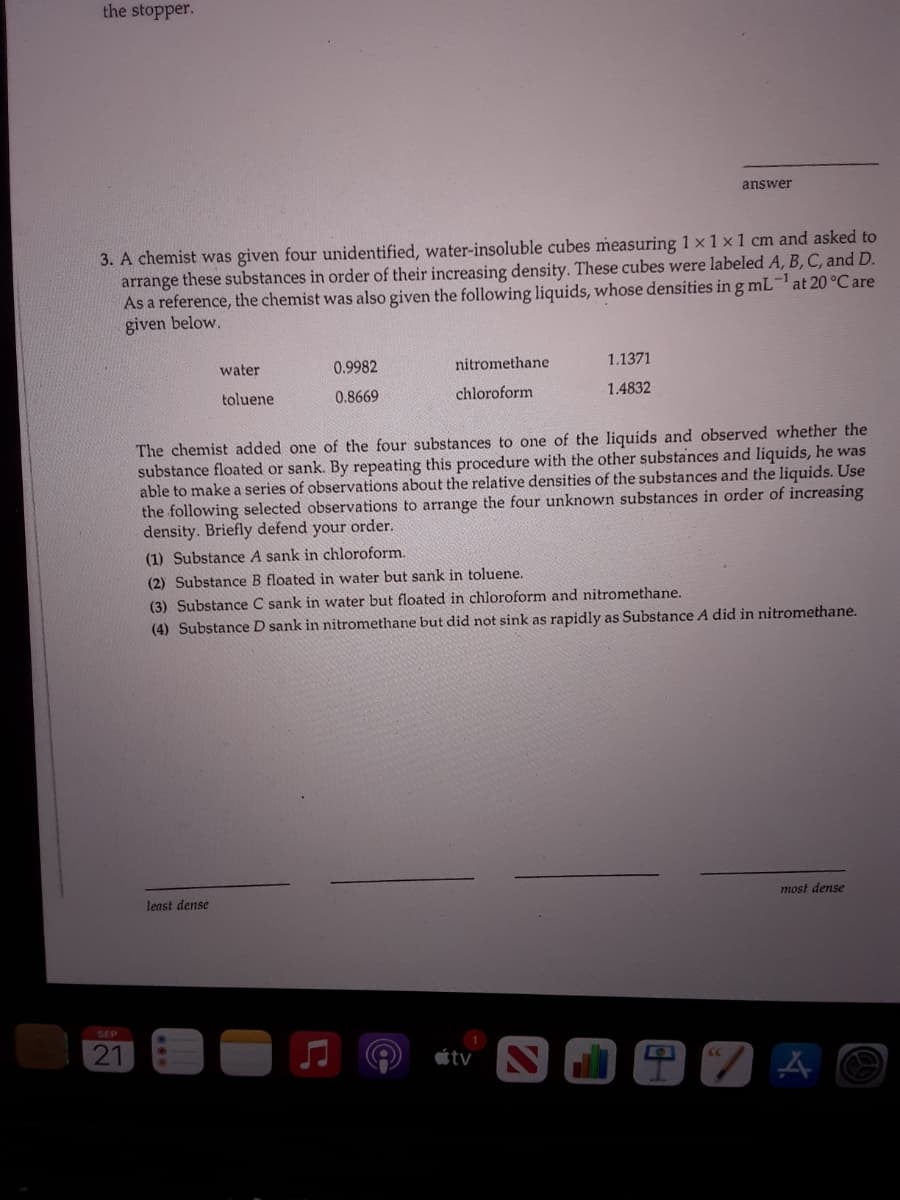answer 3. A chemist was given four unidentified, water-insoluble cubes measuring 1 x 1 x1 cm and asked to arrange these substances in order of their increasing density. These cubes were labeled A, B, C, and D. As a reference, the chemist was also given the following liquids, whose densities in g mL-at 20 °C are given below. water 0.9982 nitromethane 1.1371 toluene 0.8669 chloroform 1.4832 The chemist added one of the four substances to one of the liquids and observed whether the substance floated or sank. By repeating this procedure with the other substances and liquids, he was able to make a series of observations about the relative densities of the substances and the liquids. Use the following selected observations to arrange the four unknown substances in order of increasing density. Briefly defend your order. (1) Substance A sank in chloroform. (2) Substance B floated in water but sank in toluene. (3) Substance C sank in water but floated in chloroform and nitromethane. (4) Substance D sank in nitromethane but did not sink as rapidly as Substance A did in nitromethane. least dense most dense
answer 3. A chemist was given four unidentified, water-insoluble cubes measuring 1 x 1 x1 cm and asked to arrange these substances in order of their increasing density. These cubes were labeled A, B, C, and D. As a reference, the chemist was also given the following liquids, whose densities in g mL-at 20 °C are given below. water 0.9982 nitromethane 1.1371 toluene 0.8669 chloroform 1.4832 The chemist added one of the four substances to one of the liquids and observed whether the substance floated or sank. By repeating this procedure with the other substances and liquids, he was able to make a series of observations about the relative densities of the substances and the liquids. Use the following selected observations to arrange the four unknown substances in order of increasing density. Briefly defend your order. (1) Substance A sank in chloroform. (2) Substance B floated in water but sank in toluene. (3) Substance C sank in water but floated in chloroform and nitromethane. (4) Substance D sank in nitromethane but did not sink as rapidly as Substance A did in nitromethane. least dense most dense
Chemistry & Chemical Reactivity
10th Edition
ISBN:9781337399074
Author:John C. Kotz, Paul M. Treichel, John Townsend, David Treichel
Publisher:John C. Kotz, Paul M. Treichel, John Townsend, David Treichel
Chapter1: Basic Concepts Of Chemistry
Section: Chapter Questions
Problem 43GQ: Hexane (C6H14, density = 0.766 g/cm3), perfluoro-hexane (C6F14, density = 1.669 g/cm3), and water...
Related questions
Question

Transcribed Image Text:the stopper.
answer
3. A chemist was given four unidentified, water-insoluble cubes measuring 1 ×1 x1 cm and asked to
arrange these substances in order of their increasing density. These cubes were labeled A, B, C, and D.
As a reference, the chemist was also given the following liquids, whose densities in g mL-at 20 °C are
given below.
water
0.9982
nitromethane
1.1371
toluene
0.8669
chloroform
1.4832
The chemist added one of the four substances to one of the liquids and observed whether the
substance floated or sank. By repeating this procedure with the other substances and liquids, he was
able to make a series of observations about the relative densities of the substances and the liquids. Use
the following selected observations to arrange the four unknown substances in order of increasing
density. Briefly defend your order.
(1) Substance A sank in chloroform.
(2) Substance B floated in water but sank in toluene.
(3) Substance C sank in water but floated in chloroform and nitromethane.
(4) Substance D sank in nitromethane but did not sink as rapidly as Substance A did in nitromethane.
least dense
most dense
SEP
21
tv
CC
Expert Solution
This question has been solved!
Explore an expertly crafted, step-by-step solution for a thorough understanding of key concepts.
This is a popular solution!
Trending now
This is a popular solution!
Step by step
Solved in 2 steps with 1 images

Recommended textbooks for you

Chemistry & Chemical Reactivity
Chemistry
ISBN:
9781337399074
Author:
John C. Kotz, Paul M. Treichel, John Townsend, David Treichel
Publisher:
Cengage Learning

Chemistry & Chemical Reactivity
Chemistry
ISBN:
9781133949640
Author:
John C. Kotz, Paul M. Treichel, John Townsend, David Treichel
Publisher:
Cengage Learning

Chemistry & Chemical Reactivity
Chemistry
ISBN:
9781337399074
Author:
John C. Kotz, Paul M. Treichel, John Townsend, David Treichel
Publisher:
Cengage Learning

Chemistry & Chemical Reactivity
Chemistry
ISBN:
9781133949640
Author:
John C. Kotz, Paul M. Treichel, John Townsend, David Treichel
Publisher:
Cengage Learning